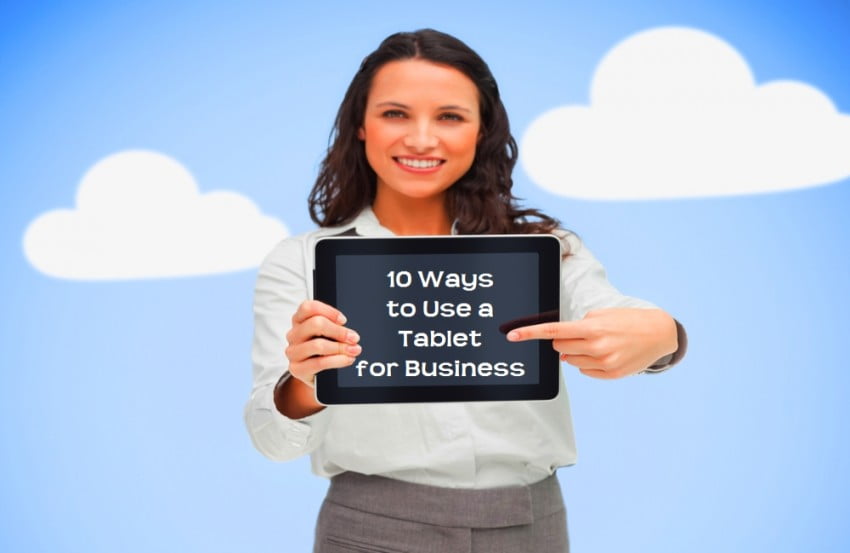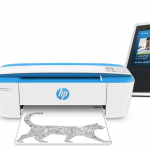
Get away from your desk. It may be ruining your creativity and productivity. If you think the iPad, BlackBerry Playbook, Google Nexus 10, or Amazon Kindle Fire — to name just a few brands — are just for entertainment or reading, think again. Tablets are quickly changing our work habits and the way our businesses operate.
We tapped into the mobility expertise of Plantronics small business marketing director, Judi Hembrough, to get her take on how small businesses are using tablets today. Below are 10 business ways lightweight tablets can untether you and your employees from your desks, help you get out among customers, and get more done in your business.
Contents
10 Ways to Use a Tablet for Business
1. Bring Your Point of Sale System to the Customer
Restaurants are placing tablets in the hands of their waitstaff, or even more revolutionary, placing the device right on the table to allow the customer to browse and send an order directly to the kitchen. You see more and more tablets at trade shows, farmers markets, and festivals where the small business owner just adds a Square, Pay Anywhere or Intuit credit card reader and can accept payments on the go. Don’t think you need to bring the customer to the cash register or order entry system – flip that around because with a tablet you bring it to your customer wherever he or she is.
2. Use Your Tablet as a Phone
I don’t mean you should hold that thing up to your ear; you’ll look quite strange. However, if you load it with Skype or Google Voice, and add a Bluetooth headset, you can easily use a tablet as an internet phone to make and receive calls.
3. Conduct Training with Multimedia
If you have to train your team, or yourself, why not sit down with a tablet where you can listen and watch? You could subscribe to a service like Lynda.com and arrange technical training for your entire team using their mobile and tablet apps. Or you can simply set up your own hand-picked curriculum on a corporate intranet.
4. Use it for Customer Relationship Management (CRM)
Of course, you can view and retrieve customer information from your Salesforce or Sage data, while in the field, but you can also use service like Cardmunch or Bump to put data into your tablet.
5. Create a Digital Portfolio
This is quite possibly one of the highest ROI uses of tablets for business – showing your presentation to a prospective client on an iPad or other tablet. It helps get sales. From photographers to real estate agents, tablets are useful for showing your digital portfolio. Plantronics marketing director, Judi Hembrough, recommends that you connect the device to a larger screen (even a TV screen) using HDMI for even better viewing. A wide number of apps can help you create a great presentation on a tablet.
6. Manage Documents
As you are noticing, a tablet is just as good as a desktop or laptop in many cases. One of the reasons for growth of the cloud is because we want access to our documents from anywhere and to any device. Keep your documents in the cloud and access them with a tablet, for true mobility.
7. Create and Edit on the Go
Document management for many people is simply an issue of accessing a static document. But for true mobility, we also want the ability to create and edit documents even when out of the office. This need to work from any device, at any time and place, has helped fuel the spectacular growth of Evernote and its competitors. I just read that the very popular Dolphin mobile browser now supports increased Evernote functionality making it easier to share websites from a tablet or phone.
When it comes to editing documents, today editing brings to mind entirely new capabilities — and you don’t need to be in your office, sitting next to a printer or a fax machine to use them. For example, you can use a tablet for receiving contracts, and then use an electronic signature platform to sign, save and return the signed documents. Services like HelloSign and Adobe’s EchoSign are very helpful for managing the signing process from a tablet. Another out-of-the-box way to “edit” and finalize documents is by creating a web form with Wufoo and then using a handy stylus like Pogo Connect to fill out the form digitally.
8. Conduct Inventory
The inventory process is always tedious, especially for those without a more sophisticated barcode system, and it usually means keeping a tally on paper. But a tablet can make the inventory tracking process a lot easier – you can use one of the many apps out there, such as Inventory Tracker, or inFlow Inventory via the web. Or you could go as far as creating your own database with the Filemaker platform for iOS. No more clipboards and taking notes in pencil.
9. Keep Track of Time
Employees can manage time tracking with tools like Toggl, Timr, or TSheets. Of course, they all have mobile apps that work on any tablet. This is especially important for businesses that bill based on hourly work, and makes sure time doesn’t slip through the cracks and is invoiced, especially when work is performed in the field, while on business trips or when employees are working from home.
10. Get Paid Faster
Okay, now we’re down to the serious part of tablets: You can issue estimates, send invoices, and scan your receipts. With FreshBooks, or Outright, or QuickBooks, you can manage your accounting right from the tablet.
If you think that shiny new Nexus 10, or iPad3, or Kindle is just for entertainment, think twice. As this list suggests, there are more apps and mobile tools available to small businesses than ever, at a price point from free to low cost, to make running a business easier. Oh, and don’t forget to get a good wireless keyboard.
How are tablets changing the way your business operates?
[“Source-smallbiztrends”]










